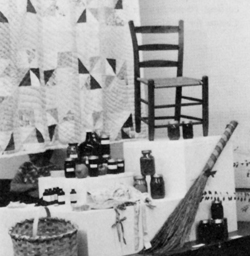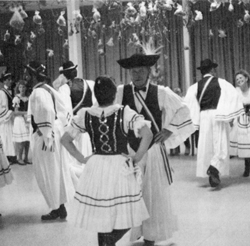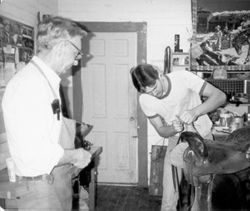Table of Contents
Folk Regions
Three Ethnic Perspectives
Folk Music of the Florida Parishes
People of the Florida Parishes
In Retrospect

The Louisiana Folklife Survey in Retrospect
By Joy J. Jackson
The Florida Parishes were the first in the state to be studied as part of the Louisiana Folklife Survey. This region was chosen in 1982 by State Folklorist Nicholas R. Spitzer, because little has been written about its customs and handicrafts. Through the collaboration of the Louisiana Folklife Program in the Division of the Arts, Office of Cultural Development, Department of Culture, Recreation, and Tourism (DOA), and the Center for Southeast Louisiana Studies, Southeastern Louisiana University, a team of researchers was assembled to interview persons in this area regarding folk customs and crafts. This publication is one of the results of that project. But th project itself stimulated much more interest in folk crafts and local lifestyles than had at first been anticipated. The following events resulted, either directly or indirectly, from its pioneering research.

At the outset of the project, in March 1983, a folklife conference was held at Southeastern to assess what had been done to study folklife in the Florida Parishes and what needed to be done. This was an all-day affair that featured speakers on the ethnic and geographical background of the area and its music, crafts and folklore. It was well attended, with about 100 participants. The interchange between the speakers and the audience clearly pointed to the topics that the researchers would have to address in their interviews.
In October 1984, the Center for Southeast Louisiana Studies cooperated with a community group, the Hammond Cultural Foundation, to sponsor jointly a folk music festival and folk crafts exhibit. The three-day folk music festival, which was held at Southeastern Louisiana University, featured country music, Italian and Hungarian ethnic music and dancing, and Black gospel singing groups. The folk crafts exhibit was held in the Hammond Cultural Foundation’s headquarters and exhibitions gallery, the Levy Building, and was under the direction of their dynamic president, Marjorie Morrison. An open house, featuring a meal of Hungarian cuisine, opened the fold crafts exhibit.
This exhibit featured a replica of a St. Joseph altar, embroidery and needlework of the Hungarian tradition, both Italian and Hungarian peasant costumes, work tools, fishing gear, and homemade jams and jellies. Pottery, musical instruments, and such countrylife relics a backporch iceboxes were on exhibit. Strawberry labels and strawberry wine were shown as well. The folklife conference had been sponsored by a grant from the Louisiana Endowment for the humanities, and the folk music festival and folk arts crafts exhibit were sponsored by the DOA.
During that same year, 1984, the Florida Parishes Folklife Survey continued, with researchers interviewing and photographing crafts people, musicians, and scenes of local customs peculiar to the Florida Parishes. Some of the artifact collected during this process became part of Folklife Pavilion of the Louisiana World Exposition in New Orleans. This Folklife Pavilion greatly increased the awareness of the Louisiana public to the richness of their folk traditions. From the Florida Parishes, the Center for Southeast Louisiana Studies sent its photographic exhibit, The Piney Woods People, which features life in Southeast Louisiana during the heyday of lumbering in the early 1900s. Local Florida Parishes musicians such as the Blackwells and Chuck Nation performed at the Folklife Pavilion.
After research was done for the Florida Parishes Survey and individual articles written, researchers sometimes continued studying and writing additional articles for publication. In the 1986-87 issue of the Southeast Louisiana Historical Papers, my article, “Plain Living in the Piney Woods: How It Is And Why It Is No More,” appeared. Ginger Romero and I also co-chaired a Hungarian Settlement Celebration in October 1987. This featured a photographic exhibit on this Livingston Parish community and a display of artifacts, both from the Settlement and from Hungary, in the Archives at Southeastern. Three programs were held: an evening of talks and traditional songs presented in the same room as the exhibit; a tour of the Hungarian Settlement which ended at the Hungarian food was served followed by a musical program; and the final event, the annual Hungarian Harvest Dance which took place at Southeastern. For the celebration, Mrs. Romero completely revised and added to her material on the Hungarian Settlement to produce a small booklet, “Hungarian Folklife: ‘The Sweet Taste of Yesterday’ in the Florida Parishes of Southeast Louisiana.” Grants for the Hungarian Settlement Celebration came from the DOA, the Louisiana Endowment for the Humanities, and the Southeastern Development Foundation. In connection with both the Folklife Survey and the Hungarian Settlement Celebration, the Center for Southeast Louisiana Studies enlarged its collection of photographs dealing with this community. Two special photographic sessions were conducted at Settlement locations to bring together favorite photographs of residents. These were copied by Center personnel. The copy negatives and prints are on file in the Center’s photographic archives at Southeastern.

The Center staff also took a complete photographic record of the fold crafts show and documented the folk music events with photographs. The Italian families interviewed by Harry Becnel lent photographs to be copied, and Ginger Romero took several rolls of film illustrating the persons, places, and customs she researched for the Folklife Survey. These negatives and photographs are all located in the center for Regional Studies. In addition to these photographs at Southeastern, many others dealing with East and West Feliciana folk craft persons and with the crafts and customs of Livingston, East Baton Rouge, and St. Tammany are in the files of the Louisiana Folklife Program in Baton Rouge.
The major contents of the material presented in this book is, of course from oral history interviews records by the various researchers. The originals of the 106 tapes are in the Center for the Regional Studies and copies are deposited with the Folklife Program in the Division of the Arts office in Baton Rouge.
A major resource in folklife which as come about since the beginning of the Florida Parishes Folklife Survey includes the publishing of Louisiana Folklife: A Guide to the State, edited by Nicholas R. Spitzer. This guide acts as a resource directly to fold arts and local traditions all over the state. It will be an invaluable aid to those who prepare the next regional folklife survey in our state following the conclusion of the Florida Parishes project. Another resource which the Louisiana Folklife Program has made use of is the collection of artifacts secured during the Florida Parishes Folklife Survey. These have been displayed in the permanent folklife exhibition in the State Capitol at Baton Rouge. This exhibition, known as The Creole State: An Exhibit of Louisiana Folklife, is a result of years of effort and research on the part of staff members in the Folklife Program. We are happy that the Florida Parishes Folklife Survey could contribute some small share of ideas and artifacts to these projects.
Finally, the Louisiana Folklife Survey form first devised to document the research done in the Florida Parishes Folklife Survey, became the permanent vehicle to recording information on folklife subjects. The completed forms are filed with the Louisiana Folklife Program to build up a directory of craftsmen, musicians, and other folk artist which may be drawn on for information in the future. The data stored by both the Center for Southeast Louisiana Studies and the Louisiana Folklife Program is open to scholars who may wish to use it for publication, exhibitions, or programs.

Within the six years that the Florida Parishes Folklife Survey went from the planning stage to completion with this publication, it set in motion the serious study and analysis of a once neglected region. This study has led to the collection of a substantial body of information in the form of tapes, photographs, and artifacts. It inspired a conference, a folk music festival, and a salute to a unique ethnic community. It encouraged further research and publication of folk-oriented articles and attracted the aid of at least five regional grants and one national grant (from the National Endowment for the Arts which sponsored the entire survey and this publication). We feel a lot has been accomplished, but a lot remains to be done in the study of local customs and traditions. With this book as a starting point, we look forward to the pure pleasure of savoring country cooking, folk craft shows, ethnic holidays, urban blues artist, and rural strawbeaters. The richness of our region’s folklife has an irresistible appeal-and one we vow to cherish and preserve as best we can for future generations.


